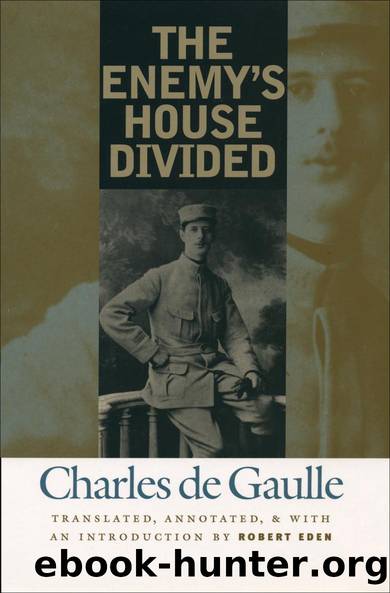The Enemy's House Divided by Charles De Gaulle

Author:Charles De Gaulle [Gaulle, Charles De]
Language: eng
Format: epub
Tags: Biography & Autobiography, Military, History, World War I, Europe, Western
ISBN: 9781469620220
Google: yXRPAwAAQBAJ
Publisher: UNC Press Books
Published: 2014-03-30T02:42:49+00:00
VII
Since the end of November, Falkenhayn had been silently preparing the offensive at Verdun. Out of mistrust and disdain, he had firmly decided to say nothing about it to Conrad. Even worse, when the chief of the Austro-Hungarian General Staff asked what his intentions were for the year 1916, he replied to him âthat the chances of an offensive in the West were very slim.â This system of dissimulation, adopted by Falkenhayn, would succeed in rendering impossible any collaboration between the two commands in the establishment of plans for common operations and in the distribution of their forces. The two Command Headquarters were going to prepare their efforts for 1916 each taking care not to let his ally know what he intended to do.
In December, seeing that Falkenhayn would definitely not agree to a march on Salonica to finish up the business in the Balkans, Conrad had resumed command over the Kovess army, which up to then had been under Mackensenâs orders. And he warned Pless of his intention to utilize Kovess immediately, to conquer Montenegro and take possession of Albania. From the Austrian viewpoint, that intention was logical, but it did not square with Falkenhaynâs. The German Chief of Staff desired from the bottom of his heart to see his allies remain everywhere on the defensive and to undertake the taskâin Russia, in the Balkans, and against Italyâof holding these fronts over the greatest possible expanse. That would enable him to withdraw almost the totality of German troops and resources from there in order to engage them in the West. But he would have to explain himself unequivocally to Conrad. However, he did not want to do that at any price.
He therefore restricted himself to finding fault with the Montenegro expedition and to giving vent to his fury against Teschen when he saw the Kovess army abandon Mackensen, despite his protestations. From that point, and during the whole month of January, the two chiefs of staff did not see each other a single time, nor did they even write each other a letter.
While Falkenhayn worked to prepare the offensive in France, Conrad naturally turned back to his old project of crushing Italy. But he had a sufficiently high appreciation of the superiority of German troops to want to have them involved in it. Before the end of November, he had set in motion a plan for an April offensive. It was to be launched from the Tyrol, directed toward Asiago, and would eventually operate in the Venetian plain in such a way as to cut the communications of the main Italian striking force at the Isonzo. It was to be executed by sixteen divisions, of which eight were to be German. In the course of his conversations with Falkenhayn, and in various notes, he presented the project to him and requested his cooperation.
Falkenhayn naturally made every possible objection. It was too early to speak of a mountain operation; in the Tyrol there were not sufficient means of transport to
Download
This site does not store any files on its server. We only index and link to content provided by other sites. Please contact the content providers to delete copyright contents if any and email us, we'll remove relevant links or contents immediately.
Machine Learning at Scale with H2O by Gregory Keys | David Whiting(4178)
Never by Ken Follett(3790)
Harry Potter and the Goblet Of Fire by J.K. Rowling(3773)
Unfinished: A Memoir by Priyanka Chopra Jonas(3332)
Fairy Tale by Stephen King(3220)
The Man Who Died Twice by Richard Osman(2997)
Will by Will Smith(2791)
Rationality by Steven Pinker(2291)
The Dark Hours by Michael Connelly(2243)
Can't Hurt Me: Master Your Mind and Defy the Odds - Clean Edition by David Goggins(2225)
It Starts With Us (It Ends with Us #2) by Colleen Hoover(2197)
The Storyteller by Dave Grohl(2171)
The Dawn of Everything: A New History of Humanity by David Graeber & David Wengrow(2122)
Friends, Lovers, and the Big Terrible Thing by Matthew Perry(2119)
The Becoming by Nora Roberts(2087)
The Stranger in the Lifeboat by Mitch Albom(2050)
Cloud Cuckoo Land by Anthony Doerr(2033)
Einstein: His Life and Universe by Walter Isaacson(1967)
Love on the Brain by Ali Hazelwood(1963)
